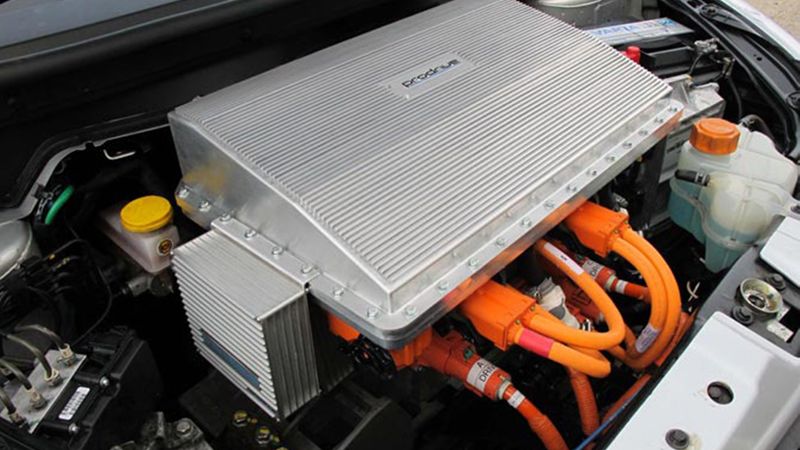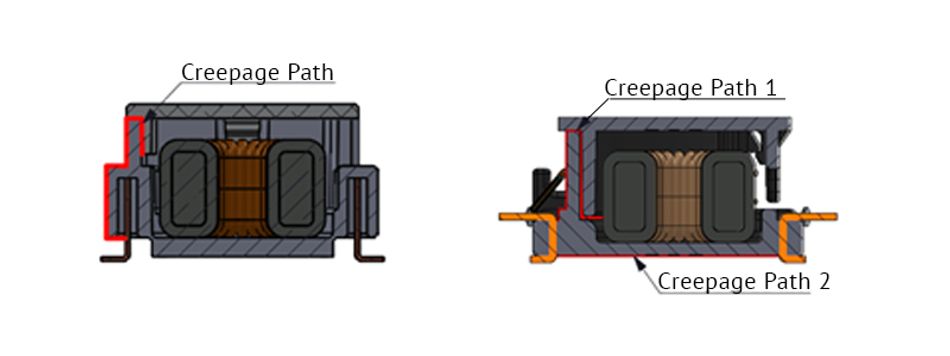Innovative Transformer Solution Addresses Traditional Challenges
Article 5 of the Power Conversion Series. An innovative transformer solution addresses many of the traditional challenges previous products had to solve.

Image: Prodrive
This is the final article in a 5-part series exploring power conversion. The series will provide insight into how the rapid electrification of vehicles and the switch to renewable energy is driving the demand for safe and reliable power conversion and electronic components.
The articles were originally published in an e-magazine, and have been substantially edited by Wevolver to update them and make them available on the Wevolver platform. This series is sponsored by Mouser Electronics, an online distributor of electronic components. Through their sponsorship, Mouser Electronics supports engineers in designing sustainable and efficient applications for a greener future.
Introduction
An electronic device that changes direct current (DC) from one voltage to another is a DC-DC converter. Typical uses range from low-voltage cell phone and laptop batteries to high-voltage circuits and power metering. As voltage increases, though, maintaining safety becomes more challenging in DC-DC converters.
Isolation
DC-DC converters employ isolation to ensure safety for operators. This approach reduces the risk of electric shock, avoids ground loops due to different potential levels, and prevents voltage transients from input to output. Engineers can achieve isolation through isolation transformers, which contain high-resistance insulation between the primary and secondary circuits to withstand the voltage between the windings. There are varying degrees of isolation, selected based on the severity of the application:
- Functional–isolated output, but no protection from electric shock.
- Basic–contains a physical barrier, offering shock protection if the barrier is intact.
- Supplementary–adds a redundant barrier to basic isolation for added safety.
- Reinforced–highest-safety choice; input and output windings are separated by a large distance or two physical barriers (like supplementary).
Push-Pull
Push-pull is a type of DC converter that uses a transformer-coupled with two transistors to convert DC voltage. Current is applied to the primary transformer circuit as the transistors are alternated between on and off states. This design draws current during both halves of the switching cycle, smoothing the input current supply. As a result, push-pull converters provide a steadier input current, create less noise on the input line, and enjoy higher efficiencies in higher-power applications than alternative styles.
Market Data
Isolated DC-DC converters are used in high-voltage circuits, power metering, healthcare technology, battery management systems, onboard charging, and CAN receivers. With such a wide span of applications, market researchers expect the isolated DC-DC converter market to reach $2.7 billion (USD) by 2024.
Given the importance of physical barriers for isolated DC-DC converters, achieving high-isolation performance in a low-profile, compact design offers design engineers an opportunity to develop an innovative solution. This paper provides an overview of the Bourns® HCT Series AEC-Q200 Compliant Power Transformer, a high-clearance and creepage isolation power transformer that incorporates the latest safety features for DC-DC conversion.
Product Solutions
The HCT series offers features well-suited for isolated DC-DC conversion applications such as automotive, industrial, communications, and consumer. They have a 6.5mm profile with more than 8mm clearance and creepage, along with reinforced insulation for working voltages up to 800VAC. The transformers are compliant with AEC-Q200, RoHS, and three IEC standards.
This transformer solution for isolated DC-DC conversion comes in a fully AEC-Q200 [jm1] compliant part, manufactured in an IATF 16949-certified factory. It offers multiple turn ratios (1:1 to 1:2.7), and design engineers can customize the high-voltage isolation performance to specific application requirements, along with additional customization options. HCT transformers are also fully validated and approved by Texas Instruments.
The HCT series components run at between -40°C and +125°C operating temperatures, and they provide up to 350mA output. The transformers also accept 3.3V-3.5V inputs and provide 3.3V-15V outputs.
Engineers designed the HCT series transformers specifically for Texas Instruments transformer driver chipsets. Below is a summary of TI SN6501 and SN6505, two chipsets that work well with the HCT components.
The SN6501 transformer driver is designed for economical, compact, isolated DC-DC converters that use push-pull topology. The driver is used in applications such as CAN, process control, industrial automation, and low- to medium-risk medical equipment. Used for input and output voltages ranging from 3-5.5V, design engineers recommend implementing a low dropout regulator (LDO) to stabilize the current supply without dependence on load. Including an LDO maximizes efficiency while providing a stable power supply.
Like the SN6501, the SN6505 transformer driver is a push-pull transformer driver, designed for compact, isolated power supplies. Applications of this driver include process control, radio supplies, medical and precision instruments, low-noise filament supplies, and low-noise isolated USB supplies. The SN6505 is low-noise and low-electromagnetic interference (EMI) in addition to push-pull capable and drives low-profile, center-tapped transformer 2.25-5.5V power supplies. Design engineers recommend LDOs with this driver as well, to maximize efficiency while providing stable source current.
Standards Compliance
As safety is the primary function of an isolation transformer, quality engineers highly value compliance with industry standards. Bourns® HCT series transformers meet the Underwriters Laboratories Inc. /International Electrotechnical Commission (UL/IEC) 62368-1 Hazard-Based Safety Standard. The intent of the standard, which takes effect in December 2020, is to provide design engineers added flexibility to incorporate new technology into their product designs.
Complying to UL is a critical gate that establishes credibility with the customer base. UL is often used as the Gold Standard for electronic device compliance and covers a broad scope of highly technical industries, such as computing and networking, consumer electronics, telecommunications, monitors and televisions, and office supplies.
An overview description of some of the critical tests of the new UL standard is below:
- Cap discharge–at 240V, the discharge voltage is measured at 2 seconds after disconnecting between line and neutral, line and ground, and neutral and ground. Pass criteria are ES1 and ES2 for normal conditions
- Touch temperature–measured at room ambient, touch temperature is measured at and outside the specification to determine the robustness of touch temperature performance
- Electrical strength–resistance to test voltage as defined within the standard
- Coin cell battery–for battery replacement, the test ensures the coin battery has appropriate safeguards against reverse charging
- Creepage distance–measures the smallest distance the charge must travel to the transformer
- Metal Oxide Varistor (MOV)–includes maximum continuous AC voltage exposure and needle flame test in addition to the prior standard IEC 61051-1 tests
- Handle securement–applies load to the transport handles at levels determined by the mechanical energy source (MS 1, 2, or 3)
- Thermal cutoff–in addition to meeting requirements in IEC 60730-1, the component withstands several thermal cycles between 30 and 3000, which is governed by equipment type and presence of automatic reset
Competitive Benchmark
While being measured against an industry standard, the HCT series outperforms two anonymous competitive benchmark components in several categories:
- High Potential Capability (tested): HCT series transformers withstood up to 7.5kV, while the competitors rated at parity and 6kV
- DC Resistance (DCR): advantage over both competitors, providing a higher degree of isolation to enable increased safety
- Thermal Derating: advantage over both competitors, dissipating more power (without enduring damage) at a given case temperature
- Working Voltage for Reinforced Isolation: the HCT transformers operate at 800VAC, while the competitive products operated between 250-400VAC
- Available Turn Ratios: more than either competitor (11 for HCT, 7 and 9 respectively for competitive parts)
- Creepage Distance: a critical metric for an isolation transformer, the HCT component contains greater than 8mm creepage distance, while the competitive transformers were at parity or 7mm
Innovative Creepage Path Design
The HCT series contains an innovative body design that enables a high minimum creepage path between the terminal and the electronics. The lid contains protrusions that extend into the body, providing an elongated, tortuous path for the current to travel. This design increases creepage while maintaining a compact package footprint by adding internal surface area that increases the distance of the current flow path as shown in the figure below.

Conclusion
The Bourns® HCT series transformers were designed with reinforced isolation, increasing creepage distance. This series can be used with several of Texas Instruments automotive application chipsets. An innovative body design contains integrated routing paths for the current, creating a compact package that maximizes creepage and overall isolation performance for safe DC-DC conversion. The components have a low-profile form factor, making them ideal for UL/IEC 62368-1 compliance. For push-pull DC-DC converters with reinforced isolation, the Bourns HCT series offers the best-in-class solution for technical performance while maintaining a small packaging size.
This article was originally written by Mouser and Bourns in an e-magazine and substantially edited by the Wevolver team. It's the final article of a 5-part series exploring power conversion.
Article 1 explored how designers can make design decisions when working with high-voltage energy storage systems.
Article 2 discussed the potential of rechargeable batteries.
Article 3 examined the method for selecting transformers for Battery Management Systems (BMS).
Article 4 explained the necessity of shunt resistors to deliver accurate Battery Management Systems.
Article 5 provided an overview of innovative transformer solutions for power conversion.
About the sponsor: Mouser
Mouser Electronics is a worldwide leading authorized distributor of semiconductors and electronic components for over 800 industry-leading manufacturers. They specialize in the rapid introduction of new products and technologies for design engineers and buyers. Their extensive product offering includes semiconductors, interconnects, passives, and electromechanical components.
